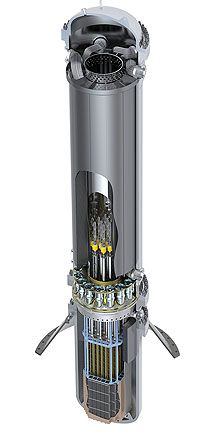The barriers to building nuclear plants are not just regulatory. These days it seems like all the plants are extra-large multi-gigawatt monsters, and those are swell, but they take several years and billions of dollars in up-front capital to build, and there are often delays and budget overruns, and local market conditions can change over the several years it takes from the time the first concrete is poured to the time when the plant comes online, so it has been very hard to find investors to back construction of new nuke plants.Part of the article wrote:Here is a bullet list of the key features of the mPower as I see them:
* Pressurized water reactor (PWR) 17 x 17 fuel bundles (Shorter than normal, but otherwise standard)
* Five year refueling schedule
* Fuel storage pool large enough for 60 years worth of fuel
* Adaptable to advances in LWR fuel (MOX or thorium)
* Below grade construction in most locations
* Air cooled condensers
* Tall, thin pressure vessel
* Passive cooling
* Manufactured system with rail delivery to site
* American engineering and manufacturing (avoids queue at Japan Steel Works)
* 125 MWe of electrical power output (I admit, I was wrong yesterday with my prediction of an even smaller system, but 125 MW is about 10th the size of the AP-1000.)
Knowing what I know about the company's performance for a very demanding customer, I feel reasonably confident that the timelines announced yesterday (design certification application in 2011, COL application in 2012, full license in 2015 and commercial operation in 2018) are not "stretch goals", but are reasonably achievable with some margin for the inevitable obstacles. Though the company made it very clear during yesterday's press conference that they are not going to be quoted on an expected cost - there are still way too many variables in the equation all with uncertainty ranges - company leaders did state that they expected to be able to produce their 125 MWe modules for a competitive price per kilowatt of capacity.
I have to admit something. While listening to the ten speakers (five from industry and three senators and two congressmen), I got a bit choked up. It was refreshing and even inspiring to hear about manufacturing reliable, affordable, zero emission power plants in North America (B&W maintains some of its manufacturing capability in Canada).
I kept thinking about all of those Americans who love to MAKE THINGS and who love to go home at the end of the day knowing that they have produced something more useful than paper, presentations or spreadsheet figures. I though about all of the people I know who enjoy bending metal and creating items of real precision and beauty. I thought about the importance to the entire economy of having reliable power systems. I thought of how nice it will be for electrical power suppliers to know that when their customers need more power they will be able to order a new unit, secure in the knowledge that it will be delivered on schedule, that it will work when it is needed, and that it's final price is the same as what the company promised.
This new reactor changes all that. It won't cost billions (B&W are vague on how much it will cost, but they're pretty clear on this point), it will have a predictable price and schedule, and the small size makes siting issues easier. Suddenly buying a nuclear reactor becomes vastly less risky, and at the same time it requires less up-front investment. These things will be manufactured in existing factories with plenty of experience making nuclear equipment, and delivered by train.
From an engineering standpoint, the design is pretty conservative. Unlike fourth-generation reactors like the various pebble bed projects, it doesn't try to introduce a new type of fuel. It's a light water reactor, so there's plenty of experience to draw upon (and it should be easier to get past the NRC). The passive safety features are nice, too.
I predict that, once over-strained electric companies can order a cheap(er) nuclear plant, guaranteed on time and for a fixed price, with a pool of trained operators and an established fuel supply chain, the floodgates will open and we'll finally see a real nuclear renaissance. If nothing else, it's way harder for the NIMBYs to protest ten little plants that are built quickly than one big plant that takes forever to finish.


